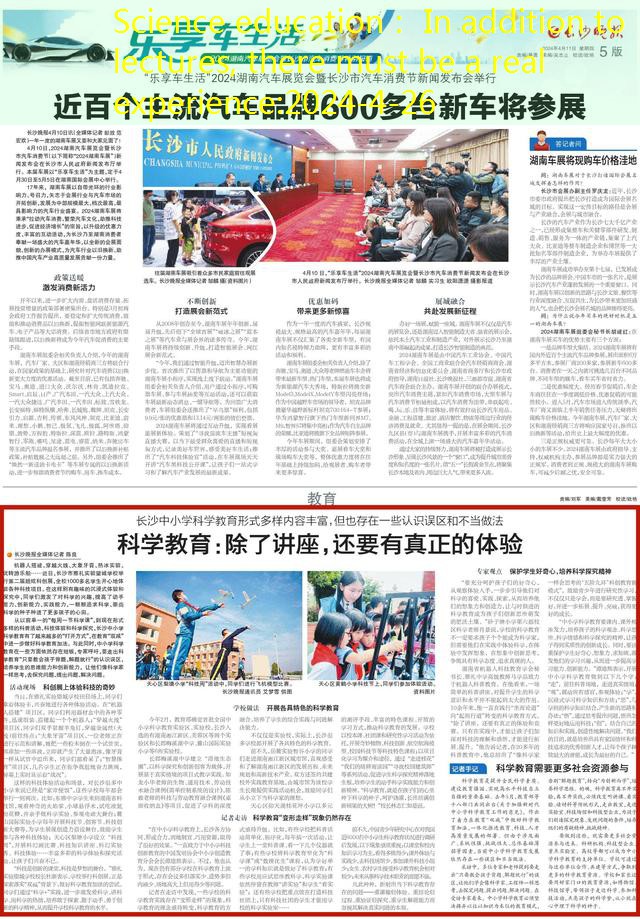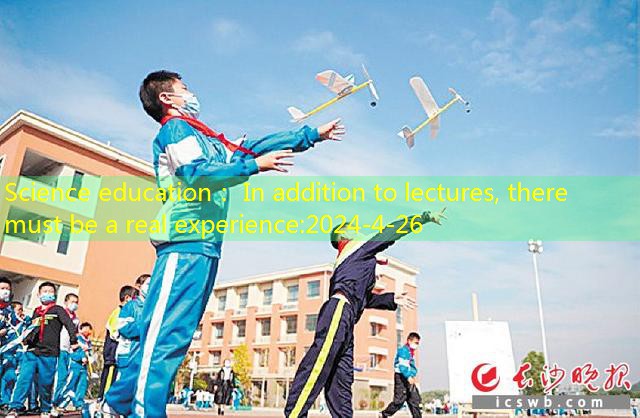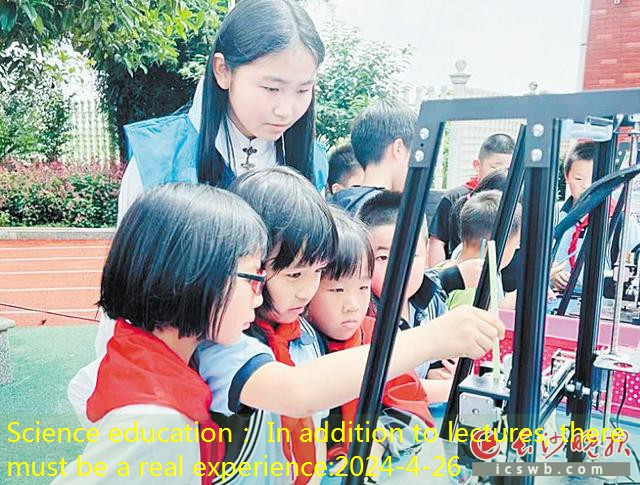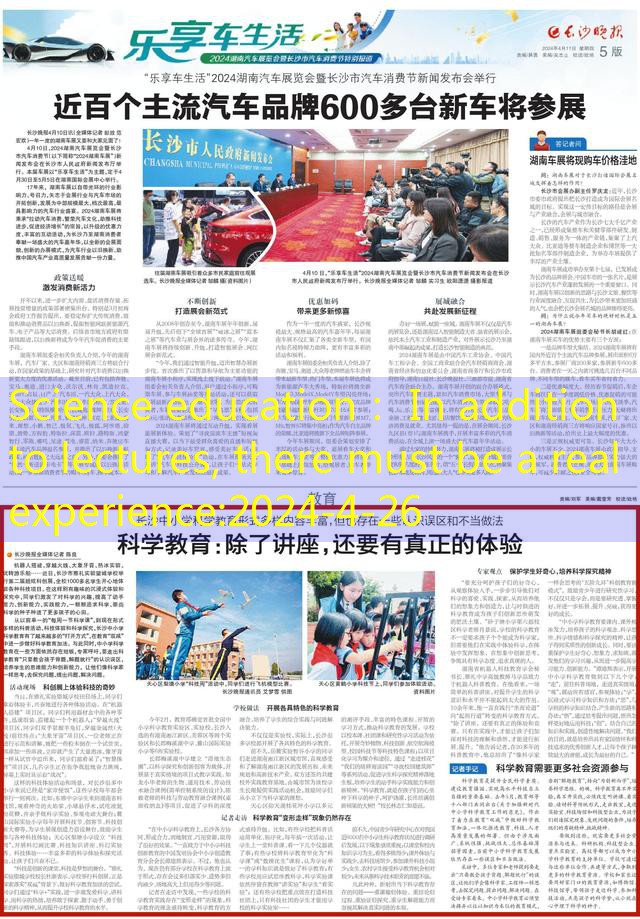
Changsha primary and secondary school science education is rich in content, but there are also some misunderstandings and improper practices
Science education: In addition to lectures, there must be a real experience
Changsha Evening News all -media reporter Chen Liang
Robot construction, crossing fire, elephant toothpaste, hot ice experiments, playing amusement ships … Recently, Changsha Yali Experimental Wangcheng School held the second Super Hyun Science and Technology Exhibition, and more than 1,000 students in the school experienced various technologies happilyproject.In this unique immersive experience and inquiry, the students have inspired their interest in science, improved their hands -on ability, innovation ability, and practical ability.Heartfield.
From the previous single “Science Course every Monday” to the current various forms of popular science activities, scientific and technological experience and scientific inquiry, there are more and more “opening methods” in Changsha primary and secondary school science education.Further do a good job of scientific education and plus law.At the same time, there are still shortcomings in some aspects of scientific education in primary and secondary schools. Experts call for a misunderstanding of scientific education “as long as you teach children to memorize problems and solve problems”, cultivate students’ thinking ability and innovation ability, and make them look likeScientists think like it, explore problems, ask questions, and solve problems.

Experience the wonderful experience of technology at the event on -site science and technology exhibition
On the same day, at the track and field fields of Wangcheng School in Yali Experiment, the students took experience cards and excitedly carried out various experience activities.In the “Robot Construction” project area, students use various parts in the equipment box to quickly assemble and set up robots; the “crossing fire line” project area, the students hold the sheep’s horns with both hands, cross the metal silk (fire line) to go to the wayEnd; the “Elephant toothpaste” project area, a teacher is conducting demonstration and explanation. She poured some powders into a test tube and added some solutions to immediately produce a large amount of foam, overflowing from the test tube like a toothpaste.Students are stunned; the “Smart Sports” project area, several students are fighting for me to jump rope, showing the “war situation” in real time on the screen.
Such scientific and technological experience activities and scenes are already “commonplace” for many primary and secondary schools in Changsha. These schools are held once or twice a year.For example: students from Dongya Middle School came to the Hunan Provincial Science and Technology Museum to watch the magical flame palm and small ball suspension, try liquid nitrogen cotton candy, and do scientific experiments and visit the stage of electromagnetics;, Maker Festival, scientific and technological innovation contest, etc., set up a stage for students to show their creativity, encourage students to participate in various scientific and technological experiences; Litang Primary School in Tianxin District set up a “Science and Technology Week” to carry out science fiction painting competitions, science and technology knowledge lectures, science fiction experiment shows,, science fiction experimental shows,, science fiction experimental shows, science fiction experimental shows,, science fiction experimental shows,, science fiction experimental shows,, science fiction experiment shows, science fiction experimental shows,, science fiction experiment shows,, science fiction experimental shows,, science fiction experiments,,Scientific and technological experience … a variety of scientific experiences and inquiry activities that make children excited.
“Technology is a class of innovation, and technology is the stage of dreams.” Du Jian, the principal of Yali Experimental Wangcheng School, said that the school’s holding of science and technology exhibitions is exactly the attempt to explore and implement the “double reduction” background and make a good attempt to make science education plus law.Through “science+” practice, students further stimulated science, science, science enthusiasm, and cultivated the scientific spirit of daring to explore, diligent in, and courageous innovation, thereby improving the level of school scientific education.
School practices carry out their unique scientific education
In February of this year, the Ministry of Education determined the first batch of national primary and secondary school science education experimental zones and experimental schools. Changsha selected in Changsha, including two experimental areas including Hunan Xiangjiang New District, Furong District, and 6 such as Meixi Lake Middle School, Lushan International Experimental Primary School.Experimental school.
Changjun Meixihu Middle School established the “Chengchi Ecosystem” to carry out scientific inquiry and innovative makers as a carrier to carry out project -based teaching practices based on real situations.For example, Teacher Long Xiaohua’s biology, general technology, and labor technology integration class “Design of Simple Control System”, Teacher Chen Yi’s science and technology and labor education fusion class “Desktop Storage Box” and other projects have promoted the deep integration of disciplines and cultivated training.Students’ comprehensive practice and problem solving ability.
Not only the experimental school, in fact, many schools in Changsha have carried out unique scientific education.
Not long ago, students from Yuelu Experimental Zhigu Elementary School walked into the Urban Museum of Xiangjiang New District, Hunan to intuitively experience and understand the development history, future planning and high -tech industries of Hunan Xiangjiang New District.The two sides also signed a contract to build an extra -school practical education base. The urban museum provides practical activities for the students for a long time, and encourages students to set up the ideal of scientists from an early age.
Guihua Ping Elementary School in Yangtian Lake in Tianxin District promotes the development of scientific education with diverse evaluation methods, rich special courses, and open learning methods.Relying on school -based classes, community classes, and research learning activities, the school carries out scientific and technological special courses such as wonderful plants, scientific and technological innovation, aviation navigation models, and campus science and technology festivals.”Our sunny and rainy garden” and “looking for campus architects” and other series of activities, promote the scientific inquiry of students to take root in the scientific inquiry of students, and cultivate students’ hands -on scientific practical ability and innovative spirit.”Scientific education is to plant the seeds of science in the hearts of children, care for pouring, and grow big trees full of innovative results!” Said the principal Lin Zhiren.

The phenomenon of “deformation and walking” of scientific education in the reporter still exists
“In the scientific education of primary and secondary schools, all parties in Changsha have collaborated and formed a joint force, and have achieved good results according to local conditions and ingenious resources.” The Chinese Invention Association, which has been committed to primary and secondary schools, has always been committed toDi Bo said.However, he also believes that some schools still have a form in scientific education. There are problems such as many meetings but less implementation, less connotation, high connotation, high venue, but less use.
During the visit, the reporter found that the scientific education practice of some schools has the phenomenon of “deformation and walking”. The concept of scientific education needs to be changed urgently, and the method of scientific education needs to be upgraded urgently.For example, some schools simplify popular science activities and procedurally, and have activities every year to allow students to take a popular science class and take a look at a few instruments.The lesson of students believes that learning a single disciplinary knowledge is to do scientific education; some schools use test -oriented thinking and science, scientific experimental courses still stay in teachers’ “experiments” and students “see experiments”; and some schools focus onIn creating science and technology communities, only students of science and technology society can use the school’s scientific laboratory …
Not long ago, the China Youth Research Center investigated the scientific education status of nearly 6,000 primary and secondary school students in my country and found that the following phenomena need to pay attention to: mainly in classrooms and in -school knowledge learning, and see more and do less; less extra -curricular experience and practice less , There are fewer to go to science and technology venues, few participating in the curriculum technology group; girls and rural students have relatively few opportunities for scientific education; in the future, they are not willing to engage in scientific and technological occupations.
All these are reflecting the problems of current scientific education -re -irrigation and lighting experience, conclusions of light process, re -verification of lighting inquiry, heavy students’ ability to solve problems, and ignoring their ability to solve real problems.
Expert viewpoint protects students’ curiosity and cultivate scientific inquiry spirit
“To fully care for the children’s curiosity, start with observation and experience, and guide them step by step to guide their love, practice, and exploration of science, so as to cultivate their imagination and creativity, so that scientific education that keeps pace with the times becomes innovative children’s innovationThe fertile soil of thinking and germination.Imagine innovative thinking, strive to be a scientific attitude and pursuit of truth.
The Secretary -General of the Hunan Robotics Science and Technology Education Society and the senior teacher Ma Xuepin, a senior teacher in Yali Middle School, is committed to robotics science education.In his opinion, a simple popular science lecture can not play a great role in improving students’ scientific awareness and level.For more than 10 years, he has been practicing the scientific education method that transforms “sitting on the road” to “rising”.”In addition to lectures, there must be a real experience and competition. Only in practice can children deepen their understanding and perception of science and technology, and can expand and improve.” He told reporters that in more than 20 years of popular science education, heIt summarizes the “Five -order and Nineth Rings’ Science and Technology Education New Models that scientists will think like scientists”, and encourage young people to conduct research learning.Breakthrough and get better growth.
“Scientific education in primary and secondary schools should be accurately exerted in class and extracurricular, cultivate children’s scientific concepts, scientific thinking, scientific emotions, and scientific inquiry spirit, so that children can get substantial innovation growth. At the same time, pay attention to protecting students’ curiosity and imagination.Powerfulness and curiosity, stimulate their learning interests, thereby further improving their learning ability and innovation ability.; “Guan”, mobilize all sensory, visit experience; “learn”, immersive learning scientific knowledge and methods; “thinking”, combining the scientific knowledge learned to generate new ideas and methods;The question, realize how to better use technology; “innovation”, combined with your own knowledge and practice, creatively solve the problem.”Our purpose is to cultivate excellent innovative talents with the feelings of family and science and technology, so that each child to release the greatest potential and grow into the best self.”
Reporter
Scientific education requires more social resources participation
Scientific education is an important foundation for improving the scientific quality of the whole people, building a strong country, and achieving high -level scientific and technological independence and self -reliance.In May last year, the eighteen departments such as the Ministry of Education jointly issued the “Opinions on Strengthening the Science Education Work of Primary and Middle Schools in the New Era”, and made a good job in doing a good job in scientific education and plus law in education “double reduction”.High -quality development deployment.However, due to factors such as widespread, strong systematic, large challenges, and weak overall foundation, there are still some misunderstandings and improper practices in the development of scientific education in primary and secondary schools.
During the interview, a number of experts and teachers mentioned that they would go out of the misunderstanding of “just teach children to memorize problems and solve problems”, so that they can learn to think like scientists and engineers to explore problems, ask questions, and solve problems.From the perspective of interviewed experts, scientific education in primary and secondary schools must resolutely abandon the educational model with knowledge -based knowledge in the past, bid farewell to “problem -solving education”, shift to “learning for innovation”, and cultivate scientific thinking.Indeed, scientific education cannot be separated from experiments and cannot be separated from practice. It is necessary to change the traditional forms of listening lectures, experiments, and reading materials. Go out of the classroom, enter the laboratory, science and technology venues, and science and technology enterprises to create inquiry phenomena for children.Find the conditions of problems to cultivate their questioning spirit and challenge spirit.
To do this, more social resources are needed to participate.Scientific research institutions, scientific and technological enterprises, key laboratories, universities, etc. can all become supporters of scientific education in primary and secondary schools.Schools can win more scientific education resources through cooperation with these units and co -construction.Schools and parents should also use educational resources at their doorsteps, such as museums, science and technology museums, etc., lead their children to approach scientific and technological activities, light up their children’s scientific dreams, and have laid scientific seeds in their hearts from an early age.
Report/feedback

